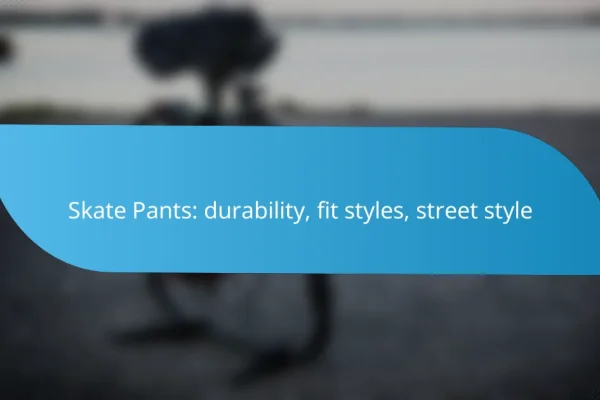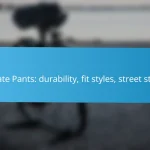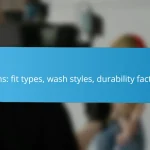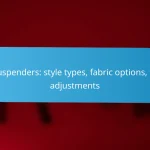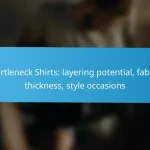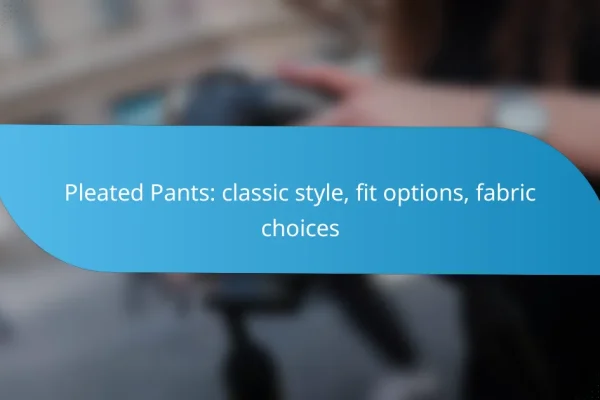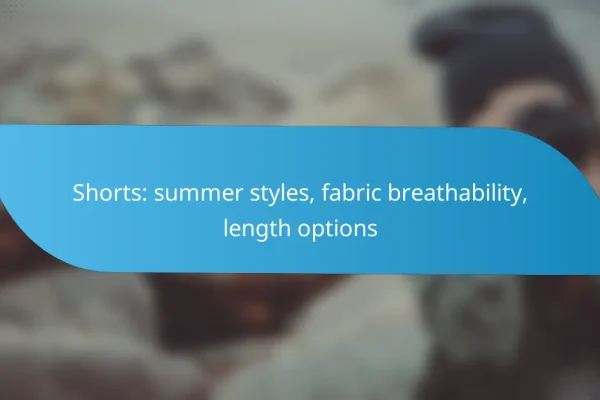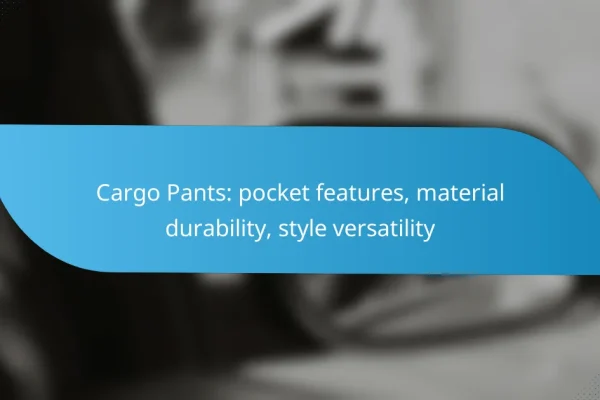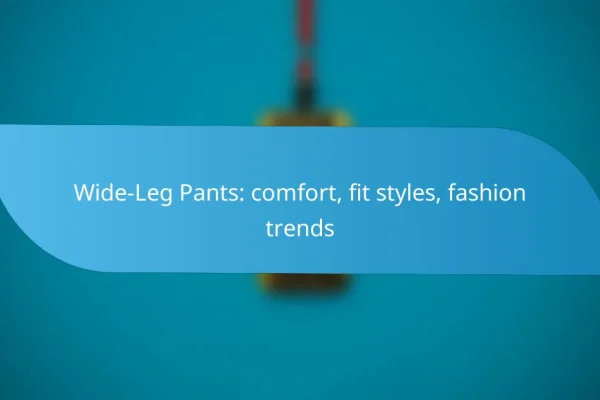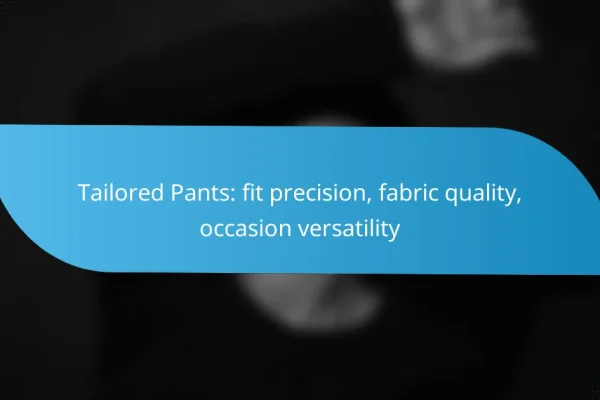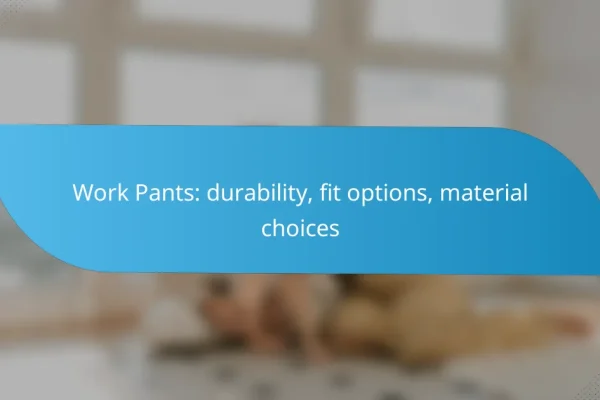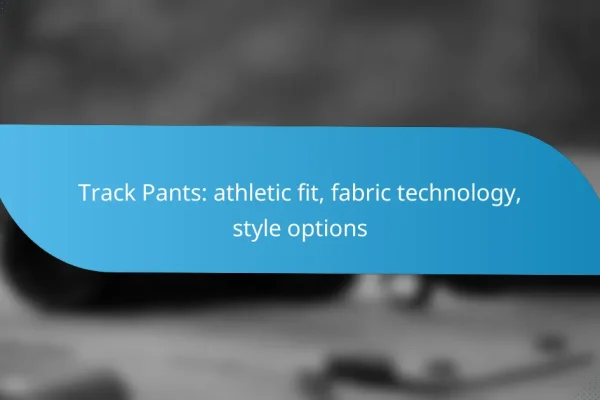What are the most popular men’s pants styles in the US?
The most popular men’s pants styles in the US include chinos, jeans, dress pants, joggers, and shorts. Each style serves different occasions and preferences, making it essential to understand their unique characteristics and suitable contexts for wear.
Chinos
Chinos are versatile pants made from cotton twill fabric, offering a balance between casual and formal wear. They typically feature a slim fit and come in various colors, making them suitable for both office settings and casual outings.
When selecting chinos, consider the fit and color that best matches your wardrobe. Light colors work well for summer, while darker shades are ideal for fall and winter. Pair them with a polo or button-down shirt for a polished look.
Jeans
Jeans are a staple in men’s fashion, known for their durability and casual style. They come in various fits, such as slim, regular, and relaxed, and are available in numerous washes and colors.
For a classic look, opt for dark-wash jeans that can be dressed up with a blazer or down with a t-shirt. Be mindful of the fit; too tight or too loose can affect comfort and style. Aim for a fit that allows for movement without being baggy.
Dress Pants
Dress pants are tailored trousers designed for formal occasions, typically made from wool or synthetic blends. They often feature a crease down the front and come in neutral colors like black, navy, or gray.
When choosing dress pants, ensure they fit well at the waist and length, as proper tailoring can enhance your overall appearance. Pair them with a dress shirt and blazer for a complete formal look, suitable for business meetings or events.
Joggers
Joggers are casual pants that combine comfort and style, often made from soft materials like cotton or fleece. They feature an elastic waistband and cuffs at the ankles, making them easy to wear for relaxed settings.
These pants are ideal for lounging or casual outings. Pair joggers with a fitted t-shirt or hoodie for a laid-back look. Be cautious with patterns; solid colors tend to be more versatile and easier to match.
Shorts
Shorts are essential for warm weather, providing comfort and breathability. Popular styles include cargo shorts, denim shorts, and tailored shorts, each serving different casual occasions.
When selecting shorts, consider the length and fit. Aim for shorts that hit just above the knee for a modern look. Pair them with a casual shirt or tank top for summer outings, and avoid overly baggy styles to maintain a polished appearance.
How to choose the right men’s pants style for different occasions?
Selecting the appropriate men’s pants style for various occasions involves understanding the dress code and comfort level required. Consider factors such as the setting, activity, and personal style to ensure you make the right choice.
Casual Outings
For casual outings, comfort and style are key. Options like chinos, jeans, or joggers work well, allowing for ease of movement while still looking put together. Pairing these with a simple t-shirt or a casual button-up can create a relaxed yet stylish look.
When choosing colors, opt for lighter shades in warmer months and darker tones during cooler seasons. Accessories like sneakers or loafers can enhance the overall appearance without compromising comfort.
Work Settings
In work settings, the choice of pants often depends on the company’s dress code. Dress pants or tailored chinos are typically suitable for business casual environments, while more formal workplaces may require slacks or suit pants. Aim for neutral colors like navy, gray, or black for versatility.
Ensure that the fit is appropriate; pants should not be too tight or too loose. Pairing them with a collared shirt or blazer can elevate the look further, making you appear professional and polished.
Formal Events
For formal events, such as weddings or galas, tailored dress pants are essential. These should be paired with a matching blazer and a dress shirt, often complemented by a tie or bow tie. Fabrics like wool or silk blends are ideal for a sophisticated appearance.
Stick to classic colors like black, charcoal, or deep navy for a timeless look. Ensure your pants are well-fitted, as tailored clothing enhances your overall silhouette and conveys a sense of elegance.
What are the key features of chinos?
Chinos are versatile pants made from cotton twill fabric, characterized by their casual yet polished appearance. They typically feature a straight leg and are suitable for various occasions, making them a staple in many men’s wardrobes.
Fabric Composition
Chinos are primarily made from cotton, which provides breathability and comfort. The fabric often includes a small percentage of synthetic fibers like polyester or elastane to enhance durability and stretch, allowing for better movement. This blend results in a fabric that is soft yet resilient, suitable for both casual and semi-formal settings.
Fit Options
Chinos come in several fit options, including slim, regular, and relaxed fits. Slim fit chinos offer a tailored look that hugs the legs, while regular fit provides a classic silhouette with a bit more room. Relaxed fit chinos are designed for maximum comfort, offering extra space in the seat and thighs, which is ideal for casual wear.
Color Variations
Chinos are available in a wide range of colors, from traditional khaki and navy to more vibrant shades like burgundy and olive. Neutral colors are often preferred for versatility, allowing easy pairing with various tops. When selecting colors, consider your existing wardrobe to ensure compatibility and ease of styling.
How do men’s jeans styles differ?
Men’s jeans styles differ primarily in fit, cut, and overall silhouette, impacting both comfort and style. Understanding these variations helps in selecting the right pair for different occasions and body types.
Skinny Jeans
Skinny jeans are designed to fit snugly from the waist down to the ankle, creating a streamlined look. They are often made from stretchy denim, allowing for comfort despite their tight fit. This style is popular among younger demographics and pairs well with fitted tops and jackets.
When choosing skinny jeans, consider your body shape; they tend to accentuate curves. Opt for a size that allows movement without being overly restrictive, as too tight can lead to discomfort.
Straight-Leg Jeans
Straight-leg jeans feature a consistent width from the knee to the hem, offering a classic and versatile silhouette. This style is flattering for various body types and can be dressed up or down, making them a staple in many wardrobes.
For a balanced look, pair straight-leg jeans with both casual and formal footwear. They are a safe choice for most occasions, and opting for darker washes can enhance their versatility for semi-formal settings.
Bootcut Jeans
Bootcut jeans are fitted through the thigh and slightly flare out from the knee to the ankle, allowing for easy wear over boots. This style balances proportions and is particularly flattering for those with wider hips or larger thighs.
When selecting bootcut jeans, ensure the flare is subtle to maintain a modern look. They work well with a variety of tops, but avoid overly baggy shirts to keep the outfit polished. Consider pairing them with heeled boots to elongate the legs further.
What should you consider when buying dress pants?
When buying dress pants, consider fit, fabric, and occasion. The right fit ensures comfort and style, while the fabric impacts durability and appearance.
Fabric Quality
Fabric quality is crucial for dress pants as it affects comfort, longevity, and overall look. Common materials include wool, cotton, and synthetic blends, each offering different benefits.
Wool is often favored for its breathability and natural stretch, making it suitable for formal occasions. Cotton is softer and more casual, while synthetic blends can provide durability and wrinkle resistance.
When selecting fabric, check for weight and texture. A weight of around 8-12 ounces is typical for dress pants, providing a good balance between structure and comfort. Always feel the fabric to ensure it meets your comfort standards.
